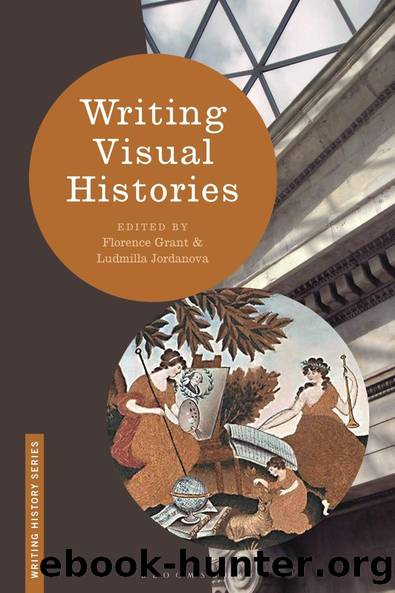Writing Visual Histories by Florence Grant Ludmilla Jordanova

Author:Florence Grant, Ludmilla Jordanova [Florence Grant, Ludmilla Jordanova]
Language: eng
Format: epub
ISBN: 9781350023451
Barnesnoble:
Publisher: Bloomsbury Academic
Published: 2020-11-12T00:00:00+00:00
Figure 18 James Watson after Robert Edge Pine, John Wilkes Esqr, 1764, mezzotint, 39 à 28 cm (15â à 11 in.). British Museum, London, 1950,0520.159 (artwork in the public domain; photograph © The Trustees of the British Museum).
The title on the spine of one book and the roundel at bottom left refer to the seventeenth-century Whig political writer Algernon Sidney, who, like Wilkes, was arrested after an illegal search of his papers. Wilkes looks up to the left, in the direction of a female figure who holds a mirror and stands behind a shield decorated with a sunburst. This is not a reference to Wilkesâs voracious sexual appetite but an allegorical figure representing Truth. Like the cap of liberty (also known as a Phrygian cap), such figures formed part of a complex system of signs (an iconography) whose meanings drew on a shared European heritage that ultimately looked back to Greek and Roman antiquity.
The study of iconography forms a sub-discipline of art history in and of itself. Pineâs usage is rather loose; Truthâs other props, or attributes, are missing. Although the Sidney references are pointed, it seems fair to assume that the allegorical figure is intended simply to suggest that Wilkesâs education and character are elevated enough to make allusions to classical civilization appropriate. Not all artists shared Pineâs view: when William Hogarth produced his engraving of Wilkes he included a cap of liberty, albeit satirically, drawing it as if it were a chamber pot (Figure 19). Pineâs portrayal, however, is clearly intended to present Wilkes as a gentleman of letters; the pose and setting are similar to those found in Pineâs portrait of the playwright and actor David Garrick. By directing Wilkesâs gaze up to Truth, rather than out to the viewer, Pine creates the impression that we are voyeurs, observing the sitter in a private reverie, further supporting the claim that what we see is the true man, not a pose.
Download
This site does not store any files on its server. We only index and link to content provided by other sites. Please contact the content providers to delete copyright contents if any and email us, we'll remove relevant links or contents immediately.
The World Almanac and Book of Facts 2021 by Sarah Janssen(837)
The emperor wears no clothes by Jack Herer(353)
The Crises of Civilization by Dipesh Chakrabarty(309)
The Way Home by Unknown(306)
History of India: A History In 50 Events by Hourly History(269)
Hidden Links by Zac Sangeeth & Sangeeth Varghese(246)
Darius in the Shadow of Alexander by Pierre Briant(246)
Prehistoric Europe by Champion Timothy. Whittle Alasdair. Shennan Stephen. Gamble Clive(237)
The History of Human Marriage by Edward Westermarck(236)
A Military History of the Cold War, 1962â1991 by Jonathan M. House(233)
Flood Legends: Global Clues of a Common Event by Charles Martin(221)
History of the Jews: An Enthralling Guide from Ancient Times to the Present (Religion in Past Times) by Wellman Billy(213)
Chinese History: 500 Interesting Facts About China (Curious Histories Collection) by Ahoy Publications(200)
The Education of Historians for Twenty-First Century by Thomas Bender; Philip F. Katz; Colin A. Palmer(196)
Big Tent by Mallory Factor(187)
Ancient Roman Sports, A-Z : Athletes, Venues, Events and Terms by David Matz(182)
Mark Of The Scots - Cl by Duncan A. Bruce(179)
Other Pasts, Different Presents, Alternative Futures by Jeremy Black(179)
The Philosophy of Historiography by John Lange(178)
